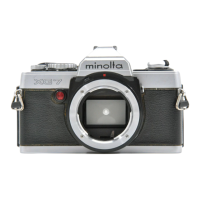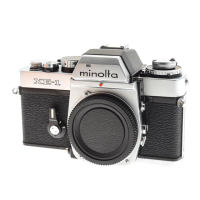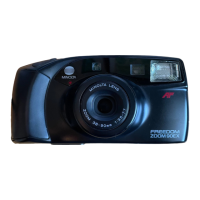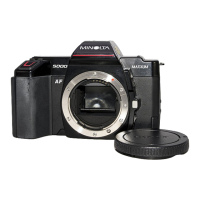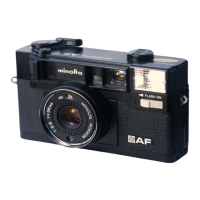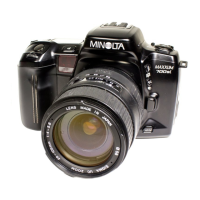m a g n e t
LEADS
Figure 96 Figure 97
SHUTTER-COCKING
LEVER ENGAGES
OPENING-BLADE
DRIVING LEVER
HERE
TRIGGER-SWITCH
LEAD
-
-----------
TRIGGER-
SWITCH
1 ECCENTRIC
g r o u n d ]
.LEAD
Figure 98
Simulate the release action by pulling
down the opening-blade driving lever,
Fig. 96. As the opening-blade set moves
down, it uncovers the aperture. The
shutter-cocking lever then latches and
holds the opening-blade driving lever,
Fig. 96.
Next disengage the closing-blade latch
and pull down the closing-blade driving
lever. When the closing-blade driving
lever reaches the position shown in Fig.
97, it strikes the latch on top of the
opening-blade driving lever.
Disengaging the latch frees the opening-
blade driving lever. The return spring then
drives the opening-blade driving lever in a
counterclockwise direction. And the open
ing blade returns to the raised position,
covering the focal-plane aperture.
On reassembly, leave the shutter dry —
no lubrication. Remember, oil quickly
works its way to the shutter blades and to
the electromagnet. Also, before you in
stall the shutter on the mirror cage, you
might double-check the operation of the
trigger switch. Connect an ohmmeter
between the black-wire terminal, Fig. 81,
and a metal portion of the shutter. With
the shutter cocked, you should read
direct continuity. You should read infinite
resistance with the shutter released.
TIMING CIRCUIT FOR ADJUSTING
THE SEIKO SHUTTER
Earlier, we mentioned that you can
build a timing circuit for adjusting the trig
ger switch. Just connect the timing cir-
'cuit to the shutter's lead wires as shown
Figure 99
in Fig. 98. There's only one problem —
you disconnect the shutter leads to
remove the shutter.
If you're also removing the flex circuit,
you can leave the shutter leads connected
to the shutter-terminal board, Fig. 98.
Disconnect the other ends of the wires
from the flex. Otherwise, you'll have to
temporarily solder wires to the shutter-
terminal board.
Then connect the test-circuit leads to
the shutter leads, Fig. 99. The magnet
leads connect to the two wires going to
the electromagnet — red and brown.
Now the test circuit supplies the power to
hold open the shutter. The trigger-switch
lead connects to the wire going to the
trigger switch, and the ground lead con
nects to any metal part of the shutter.
The trigger-switch lead and the ground
lead now connect across the shutter's
trigger switch. Remember, the trigger-
switch eccentric pin is a ground connec
tion. In some Seiko shutters, however,
you'll find that the eccentric pin does not
connect to ground. Instead, a separate
wire goes to the eccentric pin. In that
case, connect the trigger-switch lead of
the test circuit to one of the wires going
to the trigger switch; connect the ground
lead to the second trigger-switch wire.
When you now release the shutter, the
trigger switch tells the timing circuit to
start timing the exposure. You can then
use a shutter-speed tester to measure the
exposure time. The shutter should deliver
1/1000 second with the timing circuit
connected. If not, simply adjust the
trigger-switch eccentric, Fig. 98.
The timing circuit in the test box

